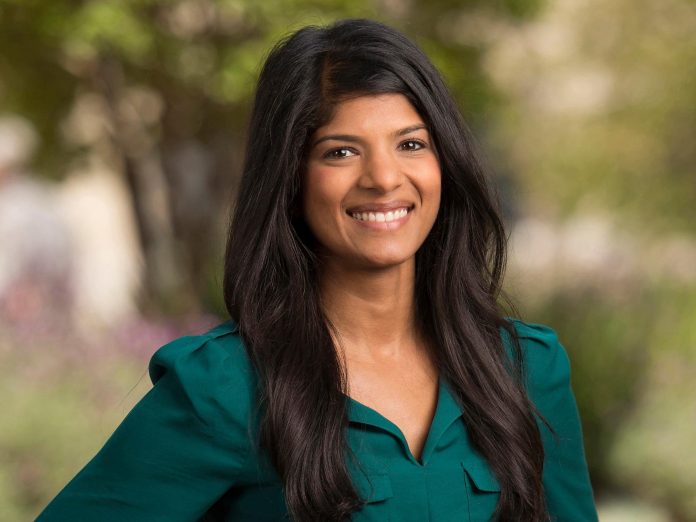Dr. Veena Jones was on her morning commute from her home in Menlo Park to her office at Lucile Packard Children’s Hospital in Palo Alto when she learned of lab test results that might have caused her to swerve off on El Camino Real if she hadn’t already been driving cautiously in the slow lane.
The 6-month old patient she was on her way to release after treatment for a rare inflammatory condition called Kawasaki disease had tested positive for the coronavirus. It was March 16, just before the widespread shelter-in-place order and long before there was any reason to consider a link between COVID-19 and the feverish and inflammatory symptoms of Kawasaki Disease.
Dr. Jones quickly conferred with her colleague, Dr. Roshni Mathew, pediatric infectious disease specialist at Packard to see if there was any precedence for this in the medical journals. They found none because Jones had hit on the first recorded diagnosis of a child with both COVID-19 and concurrent Kawasaki Disease.
“That very day I had a discussion with Dr. Mathew that we should share this with the rest of the world,” Jones said on Sunday. Their paper, “COVID-19 & Kawasaki Disease: Novel Virus & Novel Case” will be published in the Journal of Hospital Pediatrics in June. But it has been rushed into pre-publication online, and gained immediate urgency in the past week when it was revealed that 73 children in New York had been hospitalized, with three fatalities, for a mysterious disease being described as “pediatric multi-system inflammatory syndrome.”
The New York children had tested positive for the coronavirus or its antibodies, but neither they nor Jones’ patient, a South Bay girl identified only as Zara, showed respiratory symptoms. She has since gone home and passed a 14-day quarantine, and nobody knows yet whether her condition was the same as that of the children in New York, with additional cases having been reported in Chicago, Los Angeles, the United Kingdom and Spain.
“We don’t know exactly what these patients are presenting. All we know is that they look like Kawasaki disease because they have cardiac involvement,” said Dr. Mathew on Sunday. “I don’t think anyone knows for sure if there is a clear cut link to the virus but there is a suspicion of it.”
There was no suspicion when Zara was brought by her mother, identified as Mahera, to the Mountain View clinic operated by the Sutter Health Palo Alto Medical Foundation on March 10. She was given medication for the fever and sent home, with instructions to the mother to watch for worsening symptoms. Three night later she was back, with a body rash, redness of the eyes and swollen hands and feet, all common symptoms of Kawasaki.
There is no definitive test for the disease, but a blood test revealed enough of the markers that she was transferred to Packard, which has a regional reputation for treating kids with rare afflictions. Kawasaki qualifies. Though more common in Japan, it afflicts between 4,000 and 5,000 children in America per year, or 25 per 100,000 in the population.
It was early in the pandemic and the patient would not then have been suspected of suffering from COVID-19, but Packard had an early supply of tests and Zara was given one as a precaution, since she had a fever. She was then given a normal course of medication for Kawasaki and her symptoms improved dramatically.
Two days after the test, the results came back positive for the coronavirus. It was the first positive test for the coronavirus at Packard and may have been the first in the nation or the world for both Kawasaki and COVID-19.
“There was an element of surprise and we had to put our heads together with a safe plan to send her home,” said Jones, who is affiliated with the Palo Alto Medical Foundation but works at Packard. “We had not been expecting this.”
Zara did not exhibit any upper respiratory symptoms so after Jones carefully interviewed her mother she was sent home with both mother and daughter instructed to maintain quarantine for 14 days, which they both passed. Also requiring quarantine was Dr. Evie Huang who’d spent 30 or 40 minutes treating Zara at the Mountain View clinic before Zara was tested. A contact history of the family was taken, and none of them had traveled or been in knowing contact with anyone who had tested positive.
“Typically people get it from household contacts,” said Mathew. “At this point we we just don’t know how she was exposed to it. It’s a mystery.”
The doctors are careful to differentiate their patient from the clusters of cases in New York and elsewhere because she had classic Kawasaki disease, and none of the other children have received that diagnosis. But the symptoms are similar enough that there might be a connection somewhere. Mathew speculates that it could have been the coronavirus that triggered both the case of Kawasaki disease in Zara, and the cases of pediatric multi-system inflammatory syndrome elsewhere.
“The body has already seen the infection but then the immune response goes into override,” she said. “We can say it is a suspicion,” said Jones, “but not definitively.”
Zara, meanwhile, is being monitored and has passed two echocardiograms in the last two months, and ultrasounds have been normal.
“She seems to be ok,” Jones said. “She has no symptoms of COVID.”
Sam Whiting is a San Francisco Chronicle staff writer. Email: [email protected]. Twitter:@samwhitingsf






